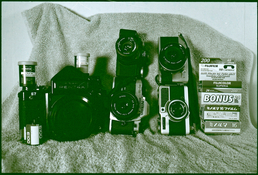albada
Subscriber
I'm renewing my interest in developers, and I'd like to create a simple developer only for XP2-super that creates dye-clouds, in order to get finer grain than one gets by developing XP2 in a B&W developer. I'm willing to weigh and mix three (possibly four) chemicals shortly before development. I'll use the developer one-shot, so if it self-destructs in a few hours, I don't care. C-41 bleach, fixer, and stabilizer last a long time, so there's no need to scratch-mix those. But true C-41 developer has a short shelf-life (a few weeks), so I want to mix it when used. Color-shifts don't matter because XP2 is black and white.
I started with the C-42 formula published by Haist in volume II, page 597. I removed the sodium bromide, KI, HAS, and anti-calcium, resulting in this 1-liter formula (scroll down if there's a large space below):
I would use this formula well below 100 F degrees, and extend development time, because color-shifts cannot occur. After development, I would do the usual bleach/fix/stabilize.
Any comments about this idea? Would grain be as fine as with true C-41 developer?
Mark Overton
I started with the C-42 formula published by Haist in volume II, page 597. I removed the sodium bromide, KI, HAS, and anti-calcium, resulting in this 1-liter formula (scroll down if there's a large space below):
| Potassium carbonate | 37.5 g |
| Sodium sulfite | 4.25 g |
| CD-4 | 4.75 |
Any comments about this idea? Would grain be as fine as with true C-41 developer?
Mark Overton





 /2 Anyway, I like his idea of adding a little ascorbic acid instead of HAS. AA is cheap and easily sourced.
/2 Anyway, I like his idea of adding a little ascorbic acid instead of HAS. AA is cheap and easily sourced.




